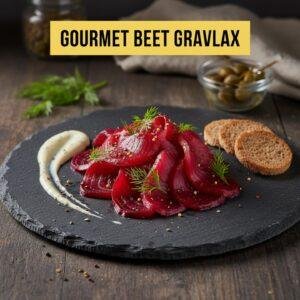
Gourmet Beet Gravlax Recipe
A sophisticated appetizer featuring vibrant beet-cured salmon gravlax paired with a creamy, tangy goat cheese panna cotta, perfect for entertaining.
Ingredients
- 500 g salmon fillet skin on
- 1 cup coarse sea salt
- 0.5 cup granulated sugar
- 2 medium raw beets peeled and grated
- 0.25 cup fresh dill chopped
- 1 tablespoon black peppercorns crushed
- 1 tablespoon vodka (optional)
- 0.5 cup heavy cream
- 0.5 cup whole milk
- 4 ounces soft goat cheese crumbled
- 1 tablespoon gelatin powder
- 2 tablespoons cold water
- 1 pinch salt
- 1 tablespoon honey (optional)
Instructions
- Rinse the salmon fillet and pat it very dry with paper towels. Ensure all pin bones are removed.
- In a bowl, combine the coarse sea salt, granulated sugar, grated beets, chopped fresh dill, crushed black peppercorns, and vodka (if using). Mix well to form the cure.
- Lay two large sheets of cling film (plastic wrap) on a clean work surface, overlapping slightly. Spoon about half of the cure mixture onto the center of the cling film.
- Place the salmon fillet, skin-side down, on top of the cure.
- Cover the salmon with the remaining cure mixture, pressing it firmly onto the flesh.
- Wrap the salmon tightly with the cling film, ensuring no air pockets. Place the wrapped salmon in a shallow dish or baking pan.
- Place a second dish or heavy object on top of the salmon to weigh it down.
- Refrigerate for 48 to 72 hours, turning the salmon every 12 hours to ensure even curing. A longer curing time will result in a firmer texture and more intense flavor.
- After curing, unwrap the salmon. Scrape off all the cure mixture. Rinse the salmon lightly under cold water to remove any remaining cure, then pat it completely dry.
- Using a sharp, thin knife, slice the gravlax very thinly on a bias, away from the skin.
- In a small bowl, sprinkle gelatin powder over cold water. Let it sit for 5 minutes to bloom.
- In a saucepan, combine heavy cream, whole milk, goat cheese, and a pinch of salt. Heat over medium-low heat, stirring constantly, until the goat cheese is melted and the mixture is warm. Do not boil.
- Remove from heat. Add the bloomed gelatin mixture and stir until completely dissolved. If using, stir in honey.
- Strain the mixture through a fine-mesh sieve into a clean bowl to remove any lumps.
- Pour the panna cotta mixture into small ramekins or serving glasses.
- Refrigerate for at least 4 hours, or until set.
- Serve thin slices of beet gravlax alongside individual goat cheese panna cottas. Garnish with fresh dill sprigs, a lemon wedge, or a sprinkle of extra black peppercorns.
Notes
For best results, allow gravlax to cure for 48-72 hours. Adjust sugar and salt in the cure to your preference. Serve gravlax thinly sliced with fresh dill and a squeeze of lemon. Use sushi-grade salmon for safety.